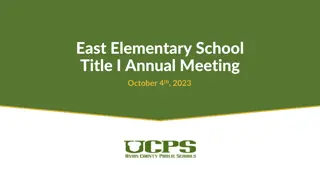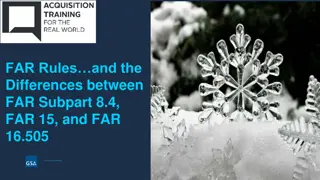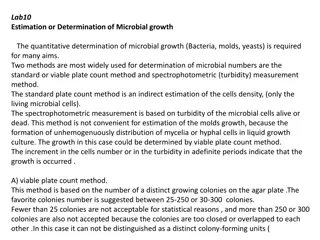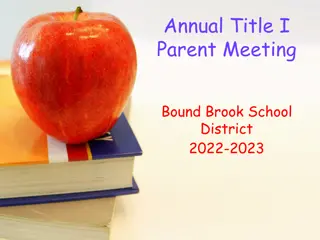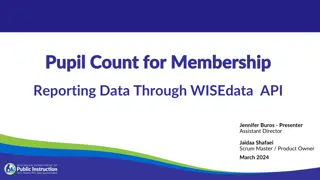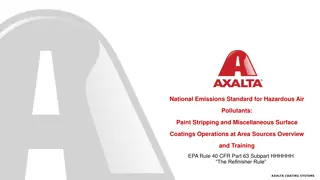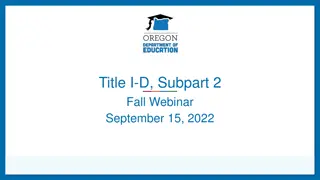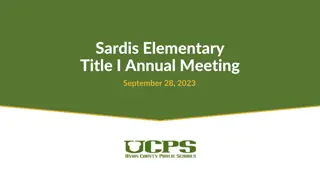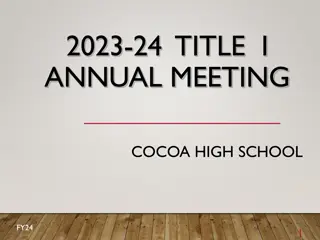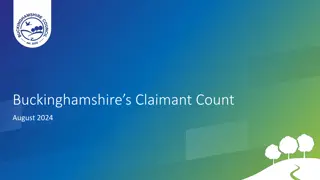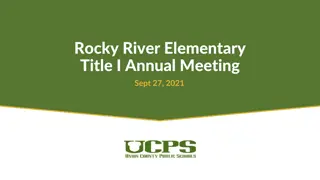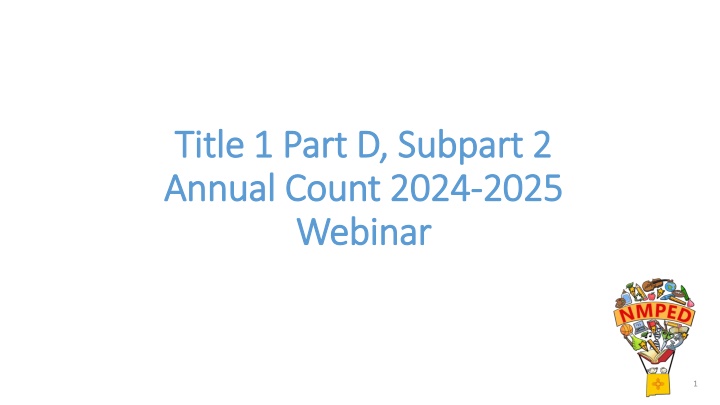
Annual Count Process for Neglected and Delinquent Youth
Explore the purpose and process of the annual count for neglected and delinquent youth in educational institutions. Learn how this count supports at-risk youth, prevents dropouts, and ensures continued education for vulnerable children.
Download Presentation

Please find below an Image/Link to download the presentation.
The content on the website is provided AS IS for your information and personal use only. It may not be sold, licensed, or shared on other websites without obtaining consent from the author. If you encounter any issues during the download, it is possible that the publisher has removed the file from their server.
You are allowed to download the files provided on this website for personal or commercial use, subject to the condition that they are used lawfully. All files are the property of their respective owners.
The content on the website is provided AS IS for your information and personal use only. It may not be sold, licensed, or shared on other websites without obtaining consent from the author.
E N D
Presentation Transcript
Title 1 Part D, Subpart 2 Title 1 Part D, Subpart 2 Annual Count 2024 Annual Count 2024- -2025 Webinar Webinar 2025 1
Objectives To provide an understanding of the purpose of the annual count. To provide information on the annual count data collection process. To provide assistance in determining eligible Local Educational Agencies (LEA) and students. 2
Agenda Purpose Process Funding Counting Contact Information 3
Purpose of the Annual Count The purpose of Title I, Part D Subpart 2 is to improve educational services for children and youth in local, tribal, and state institutions for Neglected or Delinquent children and youth so that these children have the opportunity to meet the same challenging state academic standards that all children in the state are expected to meet. To provide these children with the services needed to make the successful to further schooling or employment. To prevent at-risk youth from dropping out of school, and to provide dropouts, and children and youth returning from correctional facilities or institutions for Neglected or Delinquent children and youth, with a support system to ensure their continued education and the involvement of their families and communities. 4
Purpose of the Annual Count Institutions for neglected or delinquent children and youth include: Neglected: a public or private residential facility, other than a foster home, that is operated for the care of children who have been committed to the institution or voluntarily placed in the institution under state law due to abandonment, neglect, or death of their parents or guardians. Delinquent: a public or private residential facility for the care of children who have been adjudicated to be delinquent or in need of supervision. 5
Annual Count Process 1 Determine Eligible Local Educational Agencies 2 Determine Eligible Facilities 3 Determine Eligible Students 6
Annual Count Process Determine Eligible Local Educational Agencies: The Public Education Department (PED) requires each Subpart 2 Local Education Agency Program to reserve from its Title I, Part A allocation funds generated by the number of children in locally operated institutions for neglected or delinquent youth. These funds may be awarded to Local Education Agencies (LEAs) with high proportions of youth in local correctional facilities to support dropout prevention programs for at-risk youth. The PED has broad discretion in determining LEA eligibility. They may include youth participating in locally operated community school programs and schools not operated by the State that serve youth who are neglected or delinquent and do not live in a facility. 7
Annual Count Process Determine Eligible Local Educational Agencies: Local Educational Agencies (LEA s) that are responsible for providing public education to children and youth who are either Neglected or Delinquent. The school districts: Albuquerque Public Schools, Belen Consolidated Schools, Bernalillo Public Schools, Deming Public Schools, Farmington Municipal Schools, Hobbs Municipal Schools, Las Cruces Public Schools, Lovington Municipal Schools, Portales Municipal Schools, Roswell Independent Schools, Taos Municipal Schools and West Las Vegas Schools have been identified as Local Educational Agencies eligible under Subpart 2. 8
Annual Count Process Determine Eligible Facilities: Locally operated facilities must meet the definition of an institution for children who are neglected, an institution for children who are delinquent, or an adult correctional institution. Note: Facilities need not have a 30-day average length of stay. Facilities must be designated properly as either a neglect or delinquent institution. Facilities counted properly according to their designation (i.e., delinquent institution counted all children who are neglected or delinquent as delinquent). 9
Annual Count Process Determine Eligible Students: Students who are eligible to be served must be: Children and youth are 5 to 17 years of age during the count window. Children and youth that have not been counted in the Annual Count or other Title I funding stream count. Each unique case must be counted. (If a child or youth is enrolled at the beginning of the count window, is released, and is reenrolled later in the count window, he or she should be counted twice.) 10
Funding The US Department of Education allocates a portion of the Title 1 Part A funds to PED specifically for this subpart, based on an annual count of the number of children and youth (ages 5-17) living in local institutions for Neglected or Delinquent children for at least one day during the 30-day count period. From that allocation, PED makes subgrants to eligible Local Education Agency (LEA) facilities to provide transition services to eligible youth. 11
Definition Institution for Neglected Youth: An institution for neglected children and youth is a public or private residential facility, other than a foster home, that is operated for the care of children who have been committed to the institution or voluntarily placed in the institution under applicable State law, due to abandonment, neglect, or death of their parents or guardians. Institution for Delinquent Youth: An institution for delinquent children and youth is a public or private residential facility for the care of children who have been adjudicated to be delinquent or in need of supervision. 12
Definition An At-Risk child or youth is a school-aged individual who meets one or more of the following criteria: Is at-risk of academic failure Has a drug or alcohol problem Is pregnant or is a parent Has previously come into contact with the juvenile justice system Is at least 1 year behind the expected grade level for the age of the individual Is a migrant or an immigrant Has limited English proficiency Is a gang member Has previously dropped out of school Has a high absenteeism rate at school 13
Count Window The Count Window Subpart 2: This period is 30 consecutive days, and at least one day must be in the month of October. The PED selects the count period for all LEAs to use. 14
Contact Information Dr. Nicole O Shea Title 1 Part D Coordinator Student, School, and Family Support Bureau New Mexico Department of Education Email: nicole.oshea@ped.nm.gov Phone: (505) 531 7389 15

